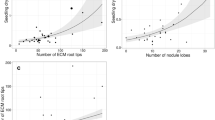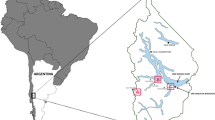Abstract
The ectomycorrhizal status of Keteleeria species is reported for the first time based on morphological and molecular analyses of root tips from southwestern China. Based on internal transcribed spacer rDNA sequences, we detected 26 ectomycorrhizal (ECM) fungal species on roots of Keteleeria evelyniana and Keteleeria davidiana collected from natural sites and a botanical garden in Kunming, China. These ECM symbionts represent six fungal lineages, including /russula–lactarius, /inocybe, /sebacina, /tomentella–thelephora, /wilcoxina, and /cenococcum. Our results provide the first evidence of ECM formation by Keteleeria and also supply ecologically important information for conservation and restoration efforts to recover populations of Keteleeria.

Similar content being viewed by others
References
Agerer R (2006) Fungal relationships and structural identity of their ectomycorrhizae. Mycol Prog 5:67–107
Boerner REJ, DeMars BG, Leicht PN (1996) Spatial patterns of mycorrhizal infectiveness of soils long a successional chronosequence. Mycorrhiza 6:79–90
Brundrett M (2009) Mycorrhizal associations and other means of nutrition of vascular plants: understanding the global diversity of host plants by resolving conflicting information and developing reliable means of diagnosis. Plant soil 320:37–77
Cox F, Barsoum N, Lilleskov EA, Bidartondo MI (2010) Nitrogen availability is a primary determinant of conifer mycorrhizas across complex environmental gradients. Ecol Lett 13(9):1103–1113
Fu LK, Chin CM (1992) China plant red data book—rare and endangered plants, vol 1. Science, Beijing, 741 pp
Fu LK, Li N, Mill RR (1999) Pinaceae. In: Wu CY, Raven H (eds) Flora of China 4. Science, Beijing, pp 11–52
García-Montero LG, Diaz P, Massimo GD, Garcia-Abril A (2010) A review of research on Chinese Tuber species. Mycol Prog 9:315–335
Gardes M, Bruns TD (1993) ITS primers with enhanced specificity for basidiomycetes—application to the identification of mycorrhizae and rusts. Mol Ecol 2:113–118
Lian C, Narimatsu M, Nara K, Hogetsu T (2006) Tricholoma matsutake in a natural Pinus densiflora forest: correspondence between above- and below-ground genets, association with multiple host trees and alteration of existing ectomycorrhizal communities. New Phytol 171(4):825–836
Lilleskov EA, Fahey TJ, Horton TR, Lovett GM (2002) Belowground ectomycorrhizal fungal community change over a nitrogen deposition gradient in Alaska. Ecology 83:104–115
Lin CP, Huang JP, Wu CS, Hsu CY, Chaw SM (2010) Comparative chloroplast genomics reveals the evolution of Pinaceae genera and subfamilies. Genome Biol Evol 2:504–517
Manchester SR, Chen Z-D, Lu A-M, Uemura K (2009) Eastern Asian endemic seed plant genera and their paleogeographic history throughout the Northern Hemisphere. J Syst Evol 47:1–42
Matsuda Y, Hijii N (1998) Spatiotemporal distribution of fruitbodies of ectomycorrhizal fungi in an Abies firma forest. Mycorrhiza 8:131–138
Matsuda Y, Hijii N (2004) Ectomycorrhizal fungal communities in an Abies firma forest, with special reference to ectomycorrhizal associations between seedlings and mature trees. Can J Botany 82:822–829
Smith SE, Read DJ (2008) Mycorrhizal symbiosis. Elsevier, London
Smith ME, Douhan GD, Rizzo DM (2007) Intra-specific and intra-sporocarp ITS variation of ectomycorrhizal fungi as assessed by rDNA sequencing of sporocarps and pooled ectomycorrhizal roots from a Quercus woodland. Mycorrhiza 18:15–22
Taberlet P, Gielly L, Pautou G, Bouvet J (1991) Universal primers for amplification of three non-coding regions of chloroplast DNA. Plant Mol Biol 17:1105–1109
Tao LY, Cheng MD (2009) Primary report on the transplantation and domestication cultivation of wild Keteleeria davidiana saplings. Guizhou For Sci Technol 37(1):55–57, 26
Tedersoo L, May TW, Smith ME (2010) Ectomycorrhizal lifestyle in fungi: global diversity, distribution, and evolution of phylogenetic lineages. Mycorrhiza 20:217–263
Vaario L-M, Xing ST, Xie ZQ, Lun ZM, Sun X, Li YH (2006) In situ and in vitro colonization of Cathaya argyrophylla (Pinaceae) by ectomycorrhizal fungi. Mycorrhiza 16:137–142
Wang B, Qiu Y-L (2006) Phylogenetic distribution and evolution of mycorrhizas in land plants. Mycorrhiza 16:299–363
Wang Y, Sinclair L, Hall IR, Cole ALJ (1995) Boletus edulis sensu lato: a new record for New Zealand. New Zeal J Crop Hort 23:227–231
White TM, Bruns T, Lee S, Taylor J (1990) Amplification and direct sequencing of fungal ribosomal RNA for phylogenetics. In: Innis MA, Gelfand DH, Sninsky JJ, White TJ (eds) PCR protocols: a guide to methods and applications. Academic, San Diego, pp 315–321
Yamada A, Katsuya K (2001) The disparity between the number of ectomycorrhizal fungi and those producing fruit bodies in a Pinus densiflora stand. Mycol Res 105:957–965
Yu FQ, Xiao YQ, Liu PG (2007) Spatiotemporal distribution of ectomycorrhizal fungi in Pinus yunnanensis forests. Acta Ecol Sinica 27(6):2325–2333
Zhang JM (1999) A preliminary study on the effect of silviculture with different seedlings of Keteleeria fortunei. J Fujian Coll Forest 19(1):73–76
Zhu JJ, Wei ZJ, Qiu XJ (1993) The experimental study on artificial reproduction of Keteleeria tree species. Sci silvae sinicae 29(1):67–71
Acknowledgments
Support for this research was provided by the National Natural Science Foundation of China (no. 30800004) and the Knowledge Innovation Program of the Chinese Academy of Sciences (no. 2010KIBA01).
Author information
Authors and Affiliations
Corresponding authors
Rights and permissions
About this article
Cite this article
Ge, ZW., Smith, M.E., Zhang, QY. et al. Two species of the Asian endemic genus Keteleeria form ectomycorrhizas with diverse fungal symbionts in southwestern China. Mycorrhiza 22, 403–408 (2012). https://doi.org/10.1007/s00572-011-0411-1
Received:
Accepted:
Published:
Issue Date:
DOI: https://doi.org/10.1007/s00572-011-0411-1




